Welcome to the Storrington and District Museum
The Storrington and District Museum
The Old School
School Lane
Storrington, West Sussex RH20 4LL
United Kingdom
ph: 01903 740188
enquirie
The Collection
Artifacts
The following notes on the Artifacts we have in the Museum has been written by Joan Ham as a series of articles in the Parish Magazine, "The Three Heralds"
The Greenfield Family
One of the paintings in the Museum by the late Mr. Bramham shows a prominent house in Church Street known as Forge House. This was originally' Duke's shoeing forge which was purchased on 22nd June 1931 by Laura Greenfield, wife of Edwin Greenfield, as a family
home. 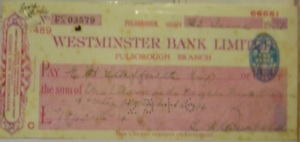
We have also displayed in the corner of the frame the cheque which she drew on the Westminster Bank Ltd. to pay E.H. Staffurth (solicitor) the sum of £1.840.16s.4d. - the purchase price. This cheque is in itself a little piece of history with its embossed 2d. blue stamp in the corner as all cheques had in those days.![]() Happily for the Museum, the Greenfield family and business never threw anything away so that every piece of paper, household object, sporting equipment, etc., was preserved, giving a very detailed picture of family and business life going back nearly 200 years. Greeenfields occupied the prime positions in the village, from (now) Bunce's as far as Tribe's Funeral Directors and in The Square from Fowler's Estate Agents to Gee Jay's shoe shop. Greenfields sold everything, as they claimed "from cradle to grave." You would buy paraffin, lamp glasses. They filled shotgun cartridges with gunpowder, every kind of ironmongery, wines and spirits, china and household goods, furniture, drapery, clothing, haberdashery, grocery and provisions, and also roasted, mixed and ground coffee beans freshly to customers' individual requirements. They delivered goods to surrounding villages and would collect items from the chemist and batteries and accumulators from the electrical shop for customers on their rounds. They even had a funeral department for their 'customers' last needs. We are fortunate indeed to have many Greenfield items in the Museum - from one of the old shop signs to business, domestic and sporting objects. How many can you identify in our Showcases?
Happily for the Museum, the Greenfield family and business never threw anything away so that every piece of paper, household object, sporting equipment, etc., was preserved, giving a very detailed picture of family and business life going back nearly 200 years. Greeenfields occupied the prime positions in the village, from (now) Bunce's as far as Tribe's Funeral Directors and in The Square from Fowler's Estate Agents to Gee Jay's shoe shop. Greenfields sold everything, as they claimed "from cradle to grave." You would buy paraffin, lamp glasses. They filled shotgun cartridges with gunpowder, every kind of ironmongery, wines and spirits, china and household goods, furniture, drapery, clothing, haberdashery, grocery and provisions, and also roasted, mixed and ground coffee beans freshly to customers' individual requirements. They delivered goods to surrounding villages and would collect items from the chemist and batteries and accumulators from the electrical shop for customers on their rounds. They even had a funeral department for their 'customers' last needs. We are fortunate indeed to have many Greenfield items in the Museum - from one of the old shop signs to business, domestic and sporting objects. How many can you identify in our Showcases?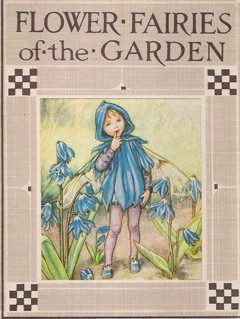
The Flower Fairies
A recent acquisition is an old postcard by Cecily Mary Barker of one of her exquisite fairies dressed to compliment a tortoiseshell butterfly, with the caption, "Good Morning". This postcard is the first one we have for our archive. C.M.B. sold her very first postcard in 1910, and continued painting animals, children, and religious subjects as well as fairy cards. At the age of sixteen she was elected to life membership of the Croydon Art Society, the youngest person to be awarded the honour of this very prestigious organisation. Cecily Mary Barker was born in Croydon on 28th June 1895, the second daughter of Walter and Mary Barker, both of whom were artistic. She was very delicate and epileptic, but her early life was comfortable and middle-class. Educated at home, C.M.B. enrolled in a correspondence course in drawing. At the age of thirteen, she exhibited her work at the Croydon Art Society, where some carvings done by her father were also displayed. The first Flower Fairy book was published in 1923. Every fairy was modelled on a real child, often one of her sister Dorothy's little kindergarten pupils. So why are we interested in this Croydon Artist? Sketching parties often took her to Surrey and Sussex, where she loved walking on the Downs and drawing the wild flowers. C.M.B. became connected with Storrington in 1930 where there was a thriving artists' colony. By the outbreak of WWII she escaped here from the bombing, and in 1942 painted a lovely peaceful landscape, "March evening in Storrington". The view is very different now, being the library and car park site. C.M.B. moved to Storrington permanently in 1968 and lived in the annexe of the The Manor House Hotel in Church Street (now demolished), having spent a great deal of time moving between Croydon and Storrington in the previous years. Number 4 Manor Close became her last home. By 1973 she was very ill and died in Worthing Hospital on 16th February. Her funeral was conducted by the Rev. George Mackenzie in St Mary's Parish Church, Storrington. Her ashes are buried in the churchyard.
The Cyclists Touring Club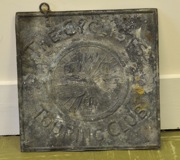 One of the perhaps less exciting looking exhibits in the Museum is a dull square metal sign about eighteen inches square showing a winged wheel and the letters "CTC" standing for "Cyclists Touring Club". This once hung outside the shop which is now called "French Connection". Wherever this sign was seen, cyclists could be sure of tea, a toilet and often bed and breakfast. Cycle touring was a very popular leisure activity between the Wars, and it was nice to know where there was such a place for a rest and refreshment at the least. "The Homestead", as the house and shop was called, was built about 1912 by Abner Soffe, a well-known character and entrepreneur in Storrington, who was, by trade, a cobbler, working from the timbered building facing westwards in all the old photographs of High Street. His business in The Homestead included a teashop, the first public toilet in the village, which could only be used by his own customers. Bed and Breakfast accommodation and, "under the counter", a thriving bookmaking and loan enterprise, much patronized by the College students
One of the perhaps less exciting looking exhibits in the Museum is a dull square metal sign about eighteen inches square showing a winged wheel and the letters "CTC" standing for "Cyclists Touring Club". This once hung outside the shop which is now called "French Connection". Wherever this sign was seen, cyclists could be sure of tea, a toilet and often bed and breakfast. Cycle touring was a very popular leisure activity between the Wars, and it was nice to know where there was such a place for a rest and refreshment at the least. "The Homestead", as the house and shop was called, was built about 1912 by Abner Soffe, a well-known character and entrepreneur in Storrington, who was, by trade, a cobbler, working from the timbered building facing westwards in all the old photographs of High Street. His business in The Homestead included a teashop, the first public toilet in the village, which could only be used by his own customers. Bed and Breakfast accommodation and, "under the counter", a thriving bookmaking and loan enterprise, much patronized by the College students
in Church Street. There were other teashops in the village at the time, and when people in obvious need came in to use his toilet, he would tell them in no uncertain terms to "take it back where you bought your tea!"
Visitors to the Museum cannot fail to notice the large shield with the Admiralty badge. This was presented to the old Chanctonbury Rural District Council during WWII as a result of a special National Savings drive during which the District exceeded the expected total. During the war people were encouraged not to spend money frivolously but to put as much as possible into National Savings by way of stamps (6d each) or Savings Certificates (15/- with interest after five years) to help pay for the war. Thirty savings stamps could be exchanged for a Certificate. Every school, organisation and business was set their own target for special weeks such as "Spitfire Week", "Support our Soldiers" and "Warship Week" among others. Chanctonbury Rural District exceeded the allotted total during Warship Week, and in particular Storrington Primary School where the children brought in their pocket money to buy savings stamps. As a "reward", the District was permitted to "adopt" ,a brand new frigate, H.M.S. Kale, and the schoolchildren wrote letters to the crew and sent them books, comforts and cigarettes, especially at Christmas. We are very honoured to display this special Admiralty plaque as a reminder of some of the efforts that ordinary people and schoolchildren made during those dark days to help their country We were unable to find a photograph of H.M.S Kale to accompany the plaque so one of our members, Peter Hilliard, did some research and painted a fine watercolour of this class of frigate, which he kindly presented to the Museum.
The Agricultural Cabinet
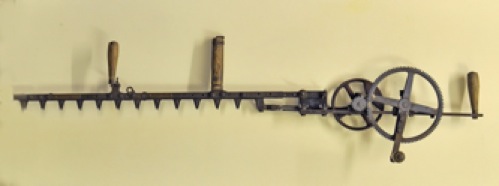
The agricultural cabinet in the Museum contains some lethal looking tools, including a monstrous hedge-trimmer, which surely took two strong men to operate, as the cutting operation required the manual turning of a wheel. Perhaps less notable are the initials burnt into the handles of forks &c. "H.V.R."' standing for Herbert Valentine Ravenscroft. Colonel Ravenscroft (1868-1952) was the last private owner of The Abbey, an estate which included all the land from the Abbey across to Chantry Lane, and a cottage in Greyfriars Lane where his dairyman lived, The estate was fairly self-supporting with a large vegetable and fruit garden, cows and pigs, wheat fields and a large ornamental garden.
Colonel Ravenscroft is immortalised in Hugh de Selincourt's classic book, The Cricket Match" which features the Colonel's Cricket Match. This was an annual event keenly anticipated by the village during the inter-war years Colonel Ravenscroft came to The Abbey in the 1920, and during the following ten years added a ball-room and music room to the building. He took a personal interest in village affairs and was a great benefactor, presenting a flag and flag-pole to the Storrington Cricket Club, becoming President of the Storrington Horticultural Society (1945) and presenting a trophy. The Church benefited from his generosity by the gift of a pulpit replacing the old Caen stone one, choirstaIls and the galleon weathervane made by Paul Hardy and Alfred Crowhurst. He was instrumental in the formation of the Comrades Club after the First World War, fore-runner of the Storrington branch of the British Legion, and presented them with the land for the Bowling Club.
When his daughter Pat married Sir Walter de S. Bartelott in 1938, a carpet was laid from the Abbey door to the church, and the whole village turned out to watch as he escorted his daughter to her wedding.
When Colonel Ravenscroft died his body was carried to the church on one of his own farm wagons, suitably draped and escorted by some of his farm workers. He is buried in the churchyard together with his wife who died in 1947. Colonel Ravenscroft's name is commemorated in the housing estate, which bears his name, and was built on what was once his farmland.
Reginald Fairfax Wells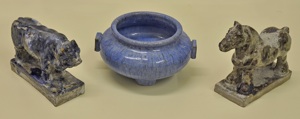 Have you noticed the pottery pieces in the end cabinet: a horse, a bull and a bowl? These are unique studio pieces made by Reginald Fairfax Wells, and featured in an arts magazine when they were made. He is perhaps better known locally as the builder of the delightful vernacular cottages at Roundabout, where he incorporated much local material. The houses were greatly sought after by London stage people as country retreats when they were built. Wells was a multi-talented man who designed aircraft in the early days of flying and had a flying school at Cobnor near Chichester. He designed a flying-boat and speedboat which were launched at Cobnor. We have an interesting archive of his work at the Museum, and in the past we have had a special exhibition featuring him.
Have you noticed the pottery pieces in the end cabinet: a horse, a bull and a bowl? These are unique studio pieces made by Reginald Fairfax Wells, and featured in an arts magazine when they were made. He is perhaps better known locally as the builder of the delightful vernacular cottages at Roundabout, where he incorporated much local material. The houses were greatly sought after by London stage people as country retreats when they were built. Wells was a multi-talented man who designed aircraft in the early days of flying and had a flying school at Cobnor near Chichester. He designed a flying-boat and speedboat which were launched at Cobnor. We have an interesting archive of his work at the Museum, and in the past we have had a special exhibition featuring him.
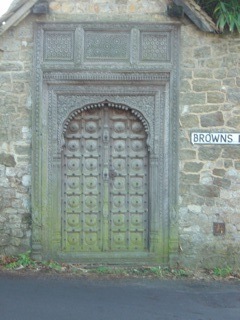
The door set in the wall at the junction of Brown's Lane and Church Street.
Books and the Library
The Museum holds a library of over 500 books and booklets of local historical interest, guides to Sussex and local churches, history and works by local authors. These books are available on loan to Society Members unless otherwise stated and are divided into the following headings:-
The Lindfield Collection
A library of valuable books was left by Eric Linfield for use by the Linfield One Name Group and loaned for safe keeping to the Museum. The Linfield One Name Group have access to these books and are available to members of the Museum Society at the discretion of the Librarian. These books are mainly guides to Sussex and on Sussex history.
Books for Sale
The museum has a number of books by local authors and of local interest which are for sale.
Maps
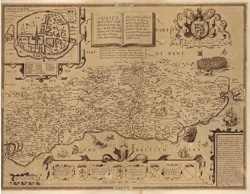
The Map collection has copies of all the Tithe Maps, 1830s to 1850s, on CDs.
The Boundary of the South Downs National Park running through the district can be seen at the museum.
Copyright 2012 Storrington Museum. All rights reserved.
The Storrington and District Museum
The Old School
School Lane
Storrington, West Sussex RH20 4LL
United Kingdom
ph: 01903 740188
enquirie